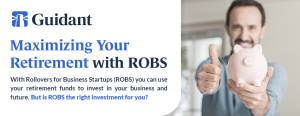Your ROBS Timeline
The first step in your timeline is to understand what you’ll be using your funds for. This step also helps you get ready for a loan. Here’s what you need.
Buying a Business with ROBS
If you’re using ROBS and/or a loan to buy a business, you’ll need to collect information on the business you’re looking to buy. The most important pieces of information are Profit and Loss statements (P&Ls) and tax returns for the last three years of the business’s operation. These documents, especially the tax returns are critical. They verify the revenue and expenses of the business. That’s what the lender will use to qualify your loan – or “hang their hat on,” so to speak. This information also helps you learn if the business is the right move for you.
Starting a Business with ROBS
If you’re using ROBS and/or a loan to start a business from scratch, you’ll need to put together a thorough business plan. A business plan outlines what your business will be and how it will be successful using key information. This info includes location and demographic information, industry statistics, competition analysis, operating plans, and more. Your business plan will be key for helping lenders see how your business will succeed and also outlines your future plan. Learn more about how to write a business plan to get approved for a loan.
Tip: The type of retirement fund you’ll be rolling money out of can also impact your timeframe. For example, Thrift Savings Plans (TSP) tend to have more red tape and can take longer to rollover than other plans.
Your ROBS and SBA Loan Timeline
If you’re using ROBS to cover all or some of your SBA loan down payment, your starting point is applying for the SBA loan.
Applying for an SBA Loan
To put together your SBA loan application, you’ll need to gather information that helps lenders understand the business you’re either starting or buying. Along with the aforementioned three years of tax returns and P&Ls and a business plan, here’s what else you’ll need.
Year to Date Financials
For active businesses being acquired, SBA lenders now require P&Ls from the start of the year to the current date and recent balance sheets. This helps lenders understand how businesses will perform after the COVID-19 pandemic. Lenders like to compare prior years of performance for the same length of time via P&Ls. They’ll use those three years of P&Ls to make the comparison. This comparison shows lenders how the business’s performance has changed from year to year.
Seller Purchase Agreement
Also, if you’re buying a business, you’ll provide a purchase agreement with the person selling the business to you. The purchase agreement includes the price of the business, its assets that are part of the sale, and other pertinent information on your purchase.
Resume
Now more than ever, lenders rely on the credibility of a borrower’s industry-related experience. You can demonstrate this with your resume. Make sure it’s up-to-date and tailored to show your experience and skills that translate into business ownership.
Three Year Projections
For both acquisitions and startups, lenders want to know what you think your financial performance in your first three years will be. You can demonstrate this through revenue, expenses, net income, etc.
SBA Forms 413 and 1919
These two SBA forms are part of the SBA application. Form 413 is a Personal Financial Statement that covers information like your liabilities and assets. Form 1919 covers borrower information like who all the business owners will be and the amount of the loan you’re requesting.
All of this information can seem daunting to gather and compile. You can get help, especially when preparing your business plan and projections, at the SBA’s Small Business Development Centers (SBDC). SBDCs are available in most metropolitan areas and are free to you. SBDCs exist to promote small business in their communities and are a great resource for aspiring small business owners.
Learn more about how to get help from Small Business Development Centers.
Loan Packaging
If you work with a loan packaging provider like Guidant, you might not need all the above information before prequalifying for your loan. It can even speed up your SBA loan timeline. Prequalifying is when your loan packager uses their experience to look at your information. They’ll help you figure out if you’re ready to apply with lenders or if there’s more you need before applying for an SBA loan.
Tip: Prequalifying for a loan isn’t the same as being pre-approved for a loan. A loan packager can let you know if they think you’re a good candidate to get approved for a loan. Loan packagers aren’t lenders. Actually getting approved for a loan comes from lenders and is contingent on putting together your loan documentations and your strength as a borrower.
For example, Guidant can prequalify your loan with:
- Our (free!) specialized credit assessment from all guarantors
- SBA form 413 (the Personal Financial Statement)
- All guarantors’ resumes
- Three years of personal tax returns
- Our SBA questionnaire
A loan packaging company like Guidant can help you apply for an SBA loan. We’ll help you put together your application, then shop that application around our broad network of lenders. The advantage of taking your application to many lenders is the possibility of finding multiple lenders interested in your business, creating competitive loan offers.
When to Start ROBS
Depending on your situation, there can be strategically beneficial triggers to start your ROBS process. We’ll cover common triggers we see among our clients. Working with a ROBS provider can help you identify triggers that work best with your unique needs.
Trigger #1 – It may make sense for you to start your ROBS after your SBA loan is deemed conditionally approved by your lender. This lets you close on the loan in time to have ROBS funds available.
Trigger #2 – Sometimes it works best to start ROBS at the time of the sales agreement and purchase of a business. This lets you form a new C Corporation, which helps protect you when signing legal agreements. Having a C Corporation can also provide opportunities for tax write-offs and present you as a more confident buyer.
Tip: Find out how long your state requires to form a C Corporation. Some states have longer processes for filing and forming a C Corporation than others. For example, both Alabama and North Dakota have about a 30-day wait to form a C Corporation. Many states take only a few days or even let you form a C Corporation immediately upon filing.
Guidant has helped clients combine the above triggers for the best outcome. We’ll help start the ROBS process including the forming of your C Corp. We can the pause the ROBS process until your SBA loan is deemed conditionally approved. Then we’ll start it again to let you close your SBA loan timeline in a good timeframe.
How Long Does an SBA Loan Take to Close?
The SBA loan timeline to close depends on factors unique to each loan.
SBA Loan Timeline: Closing for Acquisition
When you’re planning on buying a business, your SBA loan generally closes in a shorter period than if you’re starting one from scratch. On average, we see SBA loans closings for acquisitions take about 90 days from beginning to end. Keep in mind this is just on average – it could be longer or shorter depending on your specifics.
SBA Loan Timeline: Closing for Startups
New businesses often take longer to close. The longer period is usually due to negotiating a lease with a landlord. Negotiations can take two weeks or two months, depending on the building owner. Buildouts and tenant improvements can also increase the length of the SBA loan closing time. These tasks often require filing permits, getting architect renderings, and time-consuming construction. With these considerations, closing an SBA loan as a brand-new business can take anywhere from five to nine months. Again, the length of time is very dependent on what your unique business needs are. That’s why it’s so helpful to understand your needs early.
In Conclusion
The timing of your ROBS transaction, with or without an SBA loan, plays an important role. Your ROBS and SBA loan timeline matters in how quickly you can launch your business. And how you can set yourself up for the best long-term success. With our ROBS and SBA experience, Guidant can help you most effectively navigate how to get the money to start or buy your business.
If you’re ready to learn how to kick off your journey into small business ownership, call us today at 888-472-4455 or contact us online.
















